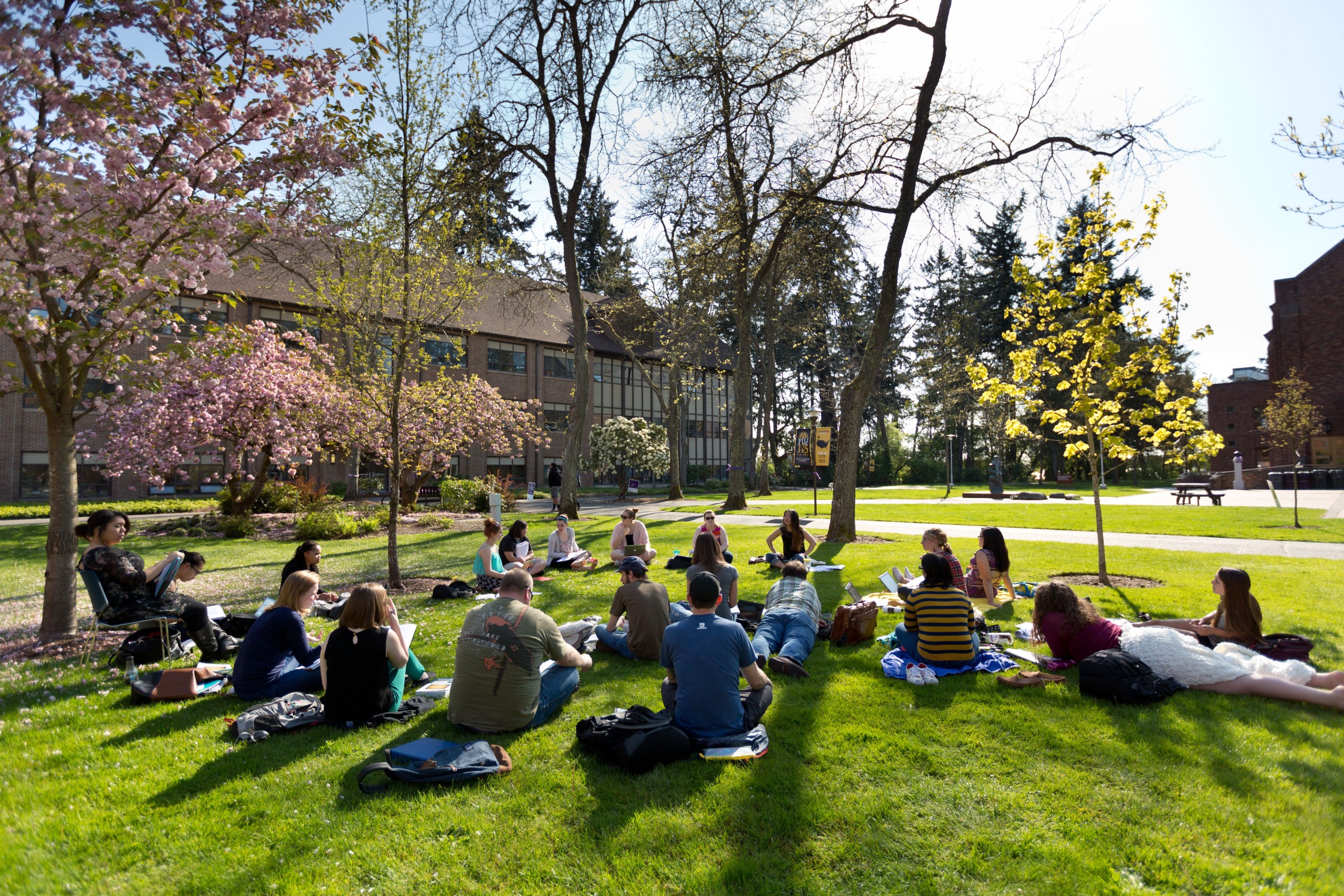Students of Color at PLU: Belonging and Persistence

Image: Outdoor class at PLU on Monday, April 20, 2015. (Photo: John Froschauer/PLU)
Following PLU’s annual University Conference kick-off, our faculty members attended a number of breakout sessions, one of which was led by Teresa Ciabattari, chair of Women’s and Gender Studies and associate professor of Sociology. Here, Dr. Ciabattari helps us understand what we can do to help PLU’s students of color feel a greater sense of belonging.
Because one of our main goals is for Pacific Lutheran University to become known for inclusive excellence—a welcoming community that engages all of its diversity in the service of student and organizational learning—I would like to delve into each a little more deeply.
What is belonging, and why is it important?
Belonging refers to students’ sense of being accepted, valued and supported in an educational setting. It is about being valued as an integral part of a community.
Encouraging student belonging means doing more than welcoming students as guests to an existing community; it means creating a culture that sees the needs of all students as equally important and creating educational conditions that support the success of all students.
Belonging is important in higher education because it is directly related to student
persistence. Researchers have found that the strongest predictors of persistence are students’:
• level of integration into the “social and intellectual fabric of an institution”;
• commitment to the institution; and
• commitment to the goal of earning a college degree (Hausmann, Schofield and Woods 2007).
Belonging is a central part of these processes.
Students’ sense of belonging can be encouraged in curricular and co-curricular realms of
university experiences. Curricularly, course content, classroom experiences and interactions with faculty can enhance or undermine student belonging. Co-curricularly, students are influenced by residential experiences, interactions with peers, and events and activities on campus.
Do students of color feel like they belong at PLU?
Data on retention and graduation show that students of color are less likely to return to PLU for a second year and less likely to graduate within four or six years. This is especially true for African-American, Asian-American and Native American students.
One of the challenges in investigating these trends is the small number of students in each of the non-white racial-ethnic categories. For example, the 2013 graduation data presented by the Chronicle of Higher Education are based on only 17 black students and 10 American Indian students. An idiosyncratic experience by only one or two of these students would significantly affect the overall rates.
Of course, the fact that the number of students in each of these groups is so small is one of the central problems shaping the experiences of students of color at PLU.
To better understand why these retention and graduation rates vary by race/ethnicity, we can look at data that focus on students’ subjective experiences at PLU. We have three main sources for this:
• The 2012 Student Satisfaction Inventory (SSI);
• The 2012 Diverse Learning Environments Survey (DLE); and
• The annual MAP-Works survey.
The SSI and DLE were given to samples of PLU students, which exacerbates the problem of small category sizes. However, multiple years of MAP-Works data can be combined to allow for more detailed analysis of the student experience across racial-ethnic categories.
The good news from these data sources is that PLU students are satisfied with the academic climate on campus. They are satisfied with our academic excellence, course content, faculty knowledge and support, opportunity for intellectual growth, empowerment to learn and academic advising.
The not-so-good news is that students of color, particularly African-American students, report lower levels of belonging to the PLU community. For example, the DLE survey found that African-American students are more likely to report being singled out in class because of their race; feeling uncomfortable sharing perspectives in class; and being dissatisfied with the racial/ethnic diversity of faculty, staff and students.
Similarly, the SSI found that African-American students were disappointed with PLU’s commitment to racial harmony. (Again, because of small sample sizes, we should interpret these findings only in the context of broader institutional knowledge and other data sources.)
Analysis of two years of MAP-Works data (fall 2013 and fall 2014) shows that African-American students, but not other students of color, report significantly lower levels of belonging than white students. This difference persists after controlling for first-generation status, commuter status, gender and high school GPA. Thus, the differences in black and white students’ reported belonging cannot be explained away by these other factors.
Race, itself, matters.
Further analysis revealed that sense of belonging is the mechanism through which black students report lower levels of learning and weaker intentions to return to PLU the following year. In other words, when black students feel like they belong, they are as likely as other students to report high levels of learning and strong intentions to return to PLU.
Thus, belonging is an important point of intervention to improve the educational experiences of African-American students, and other students of color, at PLU.
How can faculty contribute to students’ sense of belonging?
Experiences with faculty are some of the strongest ways to support student belonging. National research has shown that, for all students, “significant contact” with faculty in the first few weeks of a semester increases persistence. Other research shows that interactions with faculty members are especially important for the learning experiences and overall academic satisfaction of students of color.
What can faculty do?
Faculty can:
• Foster an environment of equity, creating learning conditions that support all students;
• Design course materials mindfully and use inclusive practices, incorporating diverse voices, materials and pedagogies’
• Be thoughtful with language, talking with students about why they use the language they do and encouraging students to reflect on their own language use and its implications;
• Address microaggressions when they observe them; and
• Do the hard work of self-reflection and self-education to be better educators for all of their students.


